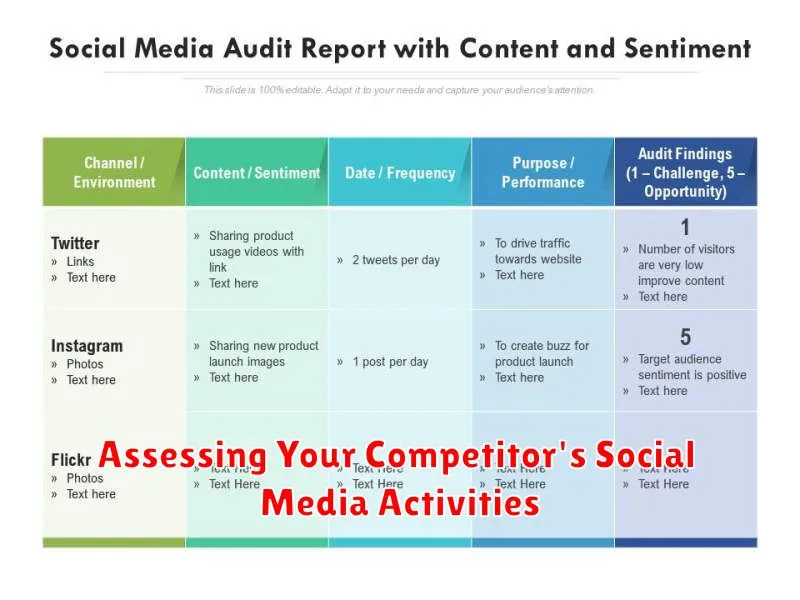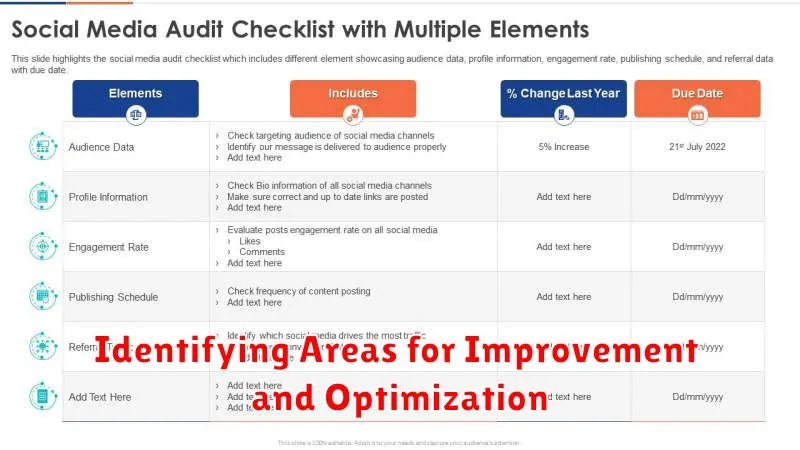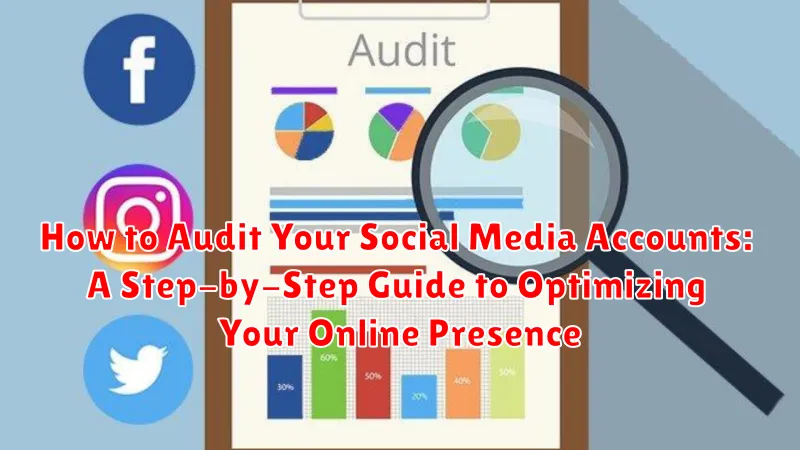In today’s digital landscape, a strong social media presence is essential for individuals and businesses alike. Whether you’re aiming to build a personal brand, promote your products or services, or connect with your target audience, optimizing your social media accounts is crucial for success. A comprehensive social media audit allows you to evaluate your current efforts, identify areas for improvement, and develop a data-driven strategy to achieve your goals. This step-by-step guide will equip you with the knowledge and tools necessary to conduct an effective social media audit and optimize your online presence for maximum impact.
This guide will cover key aspects of a social media audit, including analyzing your audience demographics, evaluating your content performance, and assessing your competitor landscape. By understanding your strengths and weaknesses across different platforms, you can refine your social media strategies and optimize your content to increase engagement, reach, and ultimately, achieve your desired outcomes. Follow these steps to unlock the full potential of your social media presence and establish a thriving online community.
Defining Your Social Media Audit Goals and Objectives
Before diving into the audit process, it’s crucial to define clear goals and objectives. This ensures your audit is focused and provides actionable insights. Ask yourself what you hope to achieve with this audit. Are you looking to increase brand awareness, drive more website traffic, generate leads, or improve customer engagement?
Clearly defined objectives will shape the scope of your audit and guide your analysis. For example, if your goal is to increase website traffic, you’ll want to pay close attention to metrics like click-through rates and referral traffic from social media. If improving customer engagement is your primary objective, metrics like comments, shares, and likes become more significant.
Consider creating a list of SMART goals (Specific, Measurable, Achievable, Relevant, and Time-bound) to keep your audit on track. This will help you measure the success of your social media efforts and demonstrate the return on investment (ROI) of your social media marketing activities.
Identifying Your Key Social Media Platforms
A crucial step in conducting a social media audit is identifying the platforms where your brand maintains a presence. This involves listing all active accounts across various social media networks. Don’t just think about the obvious ones. Consider any platform where you have created a profile, regardless of current activity levels.
Document each platform along with the associated handle or username. This creates a centralized record of your social media footprint. This inventory will be used in subsequent steps to analyze performance and assess effectiveness.
This process often reveals accounts that may have been forgotten or are no longer relevant to your current marketing strategy. These “ghost” accounts can potentially harm your brand image if they are outdated or contain inconsistent messaging. Identifying them early in the audit process allows you to address them strategically.
Consider creating a simple table to organize this information. This will help in the subsequent steps of your social media audit.
| Platform | Handle/Username |
|---|---|
| Example: Twitter | Example: @YourBrand |
Analyzing Your Current Social Media Performance Metrics
This stage involves a deep dive into the data behind your social media presence. Metrics are crucial for understanding what’s working and what’s not. Each platform offers its own analytics dashboards, providing valuable insights into your performance.
Start by examining key metrics such as reach (how many users saw your content), engagement (likes, comments, shares, and saves), and impressions (the total number of times your content was displayed). Track these metrics over time to identify trends and patterns.
Website traffic originating from social media is another important metric. Analyze how much traffic each platform is driving to your website and identify which platforms are most effective in converting visitors into customers.
Finally, consider conversion rates. This metric measures how effectively your social media efforts are contributing to your business goals, whether it’s lead generation, sales, or sign-ups.
Evaluating Your Audience Demographics and Engagement
Understanding your audience is crucial for effective social media management. This step involves deep-diving into your audience demographics and their engagement patterns.
Demographic analysis helps you understand who your audience is. Consider factors such as age, gender, location, interests, education, and occupation. Most social media platforms provide built-in analytics tools that offer these insights. This data helps tailor content to resonate with your target audience.
Engagement analysis reveals how your audience interacts with your content. Analyze metrics such as likes, comments, shares, retweets, and click-through rates. Identify high-performing content and understand what resonates best with your audience. Look for trends in engagement patterns to inform your future content strategy.
Reviewing Your Content Strategy and Brand Messaging
A crucial aspect of your social media audit involves a thorough review of your content strategy and brand messaging. This step ensures your online presence aligns with your overall marketing goals and resonates with your target audience.
Begin by analyzing the types of content you’re currently publishing. Consider the balance between promotional, educational, and entertaining posts. Is your content mix effectively engaging your audience? Does it align with your brand’s voice and values?
Next, evaluate the consistency of your brand messaging. Are you communicating a clear and unified message across all platforms? Inconsistencies can confuse your audience and dilute your brand identity. Ensure your brand voice, tone, and visual elements are cohesive.
Finally, assess the effectiveness of your current content strategy. Are your posts generating the desired level of engagement (likes, comments, shares)? If not, identify areas for improvement. Experiment with different content formats, posting schedules, and topics to discover what resonates best with your audience.
Assessing Your Competitor’s Social Media Activities

Understanding your competition is crucial for social media success. This step involves analyzing their strategies to identify opportunities and potential threats.
Start by identifying your main competitors. Who are the businesses vying for the same audience? Once identified, examine their social media presence across the platforms relevant to your business.
Analyze their content strategy. What type of content are they posting (videos, images, text)? How frequently do they post? What is their brand voice and tone? Look for patterns in their posting schedule and content types that generate high engagement.
Investigate their audience engagement. How are their followers interacting with their content? What is the sentiment (positive, negative, neutral)? This can offer insights into what resonates with your target audience.
Finally, assess their overall social media performance. How many followers do they have? How quickly are they growing their audience? This analysis provides a benchmark against which to measure your own progress.
Identifying Areas for Improvement and Optimization

After analyzing your social media performance, audience, content, and competitors, the next crucial step is to pinpoint areas ripe for improvement and optimization. This involves critically examining the data collected and identifying discrepancies between your current performance and your desired outcomes.
Look for weaknesses in your social media strategy. Are you posting consistently? Is your engagement low? Are your visuals impactful? Is your brand messaging consistent across platforms? Identifying these weaknesses provides a foundation for targeted improvements.
Next, identify opportunities to enhance your social media presence. Perhaps you could leverage a trending hashtag, partner with an influencer, or experiment with a new content format. Explore untapped potential to maximize your reach and impact.
Consider the following areas for potential improvement:
- Content Quality: Is your content engaging, informative, and relevant to your target audience?
- Posting Frequency: Are you posting too often, not enough, or at the wrong times?
- Platform Relevance: Are you using the right platforms to reach your target audience?
- Hashtag Usage: Are you using relevant and effective hashtags to increase discoverability?
- Engagement Strategies: Are you actively engaging with your followers and fostering a community?
By thoroughly examining these aspects, you can develop a targeted approach to optimize your social media efforts and achieve your desired results.
Creating an Action Plan for Implementing Audit Recommendations
After identifying areas for improvement, translate your audit findings into a concrete action plan. This plan serves as your roadmap for optimizing your social media presence.
Prioritize your recommendations. Focus on high-impact changes that align with your audit goals. For example, if low engagement is a key issue, prioritize content strategy adjustments over minor profile updates.
Establish a clear timeline. Set realistic deadlines for implementing each recommendation. Breaking down large tasks into smaller, manageable steps can make the process less daunting.
Assign responsibilities. If you manage multiple accounts or work within a team, clearly define who is responsible for each task. This ensures accountability and streamlines the implementation process.
Document your action plan. Use a spreadsheet or project management tool to organize your tasks, deadlines, and assigned personnel. This provides a central hub for tracking progress and making adjustments as needed.
Tracking and Measuring the Impact of Your Social Media Audit
After implementing the changes identified in your audit, consistent tracking and measurement are crucial to gauge their effectiveness. This ongoing process validates your efforts and reveals what’s working and what requires further adjustment.
Key Performance Indicators (KPIs) should align with your initial audit goals. If your objective was to increase brand awareness, track metrics like reach, impressions, and share of voice. If your goal was to drive conversions, focus on website clicks, lead generation, and sales.
Establish a regular reporting schedule, whether weekly, bi-weekly, or monthly, to monitor progress. Use analytics dashboards provided by each social media platform or consider third-party social media management tools for a consolidated view.
Don’t just collect data; analyze the trends. Look for correlations between implemented changes and KPI movements. Are your engagement rates improving? Is your reach expanding? These insights inform future strategy adjustments and refine your social media approach over time.

